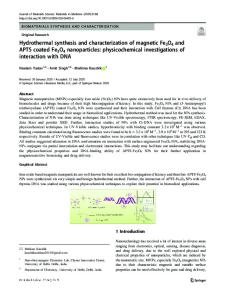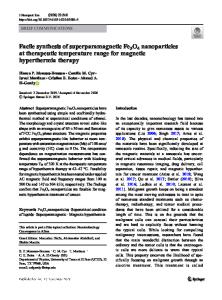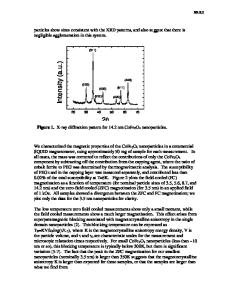Synthesis and Characterization of Co 0.6 Zn 0.4 Mn 0.3 Fe 1.7 O 4 Magnetic Nanoparticles
- PDF / 1,028,630 Bytes
- 6 Pages / 612 x 792 pts (letter) Page_size
- 75 Downloads / 365 Views
Synthesis and Characterization of Co0.6Zn0.4Mn0.3Fe1.7O4 Magnetic Nanoparticles Arti Gupta1 and R. P. Tandon1 1
Department of Physics and Astrophysics, University of Delhi, Delhi 110007, India.
ABSTRACT In the recent time spinel ferrite magnetic nanoparticles have been largely studied owing to various applications of these materials in the information storage, ferro-fluid technology, magnetocaloric effect, refrigeration and medical diagnostics. In this category cobalt ferrite (CoFe2O4) nanoparticles specifically gained huge research attention and prepared by various chemical methods. However, further investigations are still needed on the substituted CoFe2O4 (CFO) nanoparticles to explore their various characteristics. In this paper we present our results on Mn and Zn substituted cobalt ferrite (Co0.6Zn0.4Mn0.3Fe1.7O4 ) nanoparticles prepared by chemical co precipitation method. The x ray diffraction pattern of as prepared Co0.6Zn0.4Mn0.3Fe1.7O4 (CZFMO) nanoparticles indicated their average particle size =20 nm. Magnetic properties of these nanoparticles before and after thermal annealing have been compared. Magnetization (M) vs. field (H) loop measurements at T = 293 K on as prepared and thermally annealed CZFMO nano powders revealed an unusual feature contrary to CFO nanoparticles prepared under same conditions. The saturation magnetization (Ms) decreases after the thermal annealing unlike the usual increase in Ms observed for CFO nanoparticles. These nano sized CZFMO powder samples are further characterized by low temperature magnetic measurements; Raman spectroscopy and Fourier transform infrared spectroscopy. INTRODUCTION In the recent years nano-crystalline ferromagnetic spinels have been largely studied [1, 2] owing to their various applications in the field of information storage systems, magnetocaloric effect, ferro-fluid technology, refrigeration, medical diagnostics etc. The unit cell of each ferromagnetic spinel consists of 32 oxygen atoms in a closed packed cubic structure with 64 tetrahedral (A) and 32 octahedral (B) sites. CFO is an inverse spinel wherein 8 Co+2 ions are situated at the B site whereas 16 Fe+3 ions are equally distributed on A and B sites. The influence of heat treatment (or increasing particle size) on the magnetic properties of CFO nanoparticles has been widely investigated in literature [3, 4]. The properties of ferrimagnetic spinel have a marked dependence on the type of cations and their distribution over the two sites. Moreover, the cation distribution is largely dependent on the temperature as well as the synthesis procedure. Substitution of Mn for Fe and Zn for Co has been shown to drastically decrease the coercivity (compared to pure CFO) keeping the saturation magnetization = 78 emu/g (comparable to that of pure CFO) for the modified CFO composition Co0.6Zn0.4Mn0.3Fe1.7O4 (CZFMO) in our earlier publication [5]. The neutron diffraction studies (not shown here) on the bulk CZFMO established its mixed spinel type cation distribution and showed that Mn+3 ions preferentially go
Data Loading...











